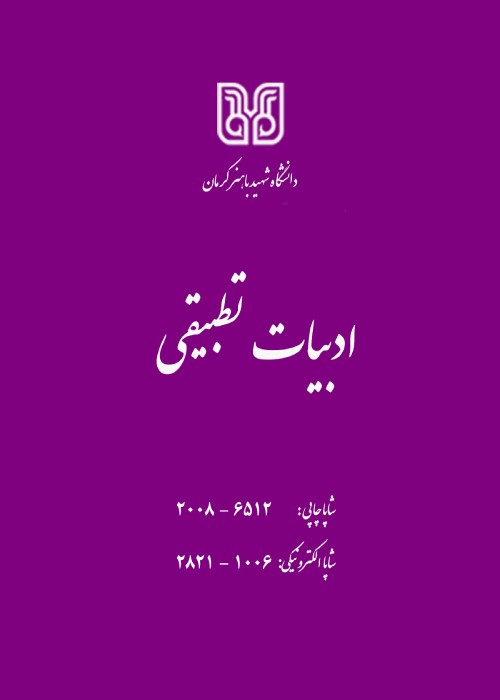Composition in Indian Style: Nazok-khiyal and Dur-khiyal
Paying attention to the syntactic and rhetorical patterns of composition leads to the discovery of the main techniques of the poets of each period. The composition was an important characteristic of Indian style poetry (Shafi'i Kodkani, 1987: 64). The style has lasted for three centuries and includes various styles (Hasanpour Alashti, 2005: 19). This research investigates and describes the procedure and frequency, and patterns of composition, in two branches of Isfahani's Nazok-khiyal (delicate Imagination) and Indian Dur-khiyal (remote Imagination) in Indian style. However, research has already been done on the Special vocabulary compounds and genitive, and attributive compositions of the poetry of this style based on generative-transformational grammar, but those studies don’t care about the unique characteristics of the combination in Indian style and didn’t pay attention to the significant differences in composition between the two important branches of the Indian style.
This article, based on Semantic relations and the existence or non-existence of the determination and the head, in semantic relations, classified the compounds into two branches: Endocentric compounds and Exocentric Compounds (Bloomfield, 2000: 222).
In this essay, the meaning of composition is close to the logical meaning of the composition. It means the words, phrases, or sentences that created the complete concept (Mohaghegh, 2007: 42). To accurately examine the routine of complexity and techniques of poets, the poets were classified into: the poets of Nazok-khiyal (delicate Imagination) style: Baba faghani, Orafi, Naziri, Kalim, and Hazin, and the poets of Dur-khiyal (remote Imagination) style: Zolali Khansari, Asir shahrestani, Ghani Kashmiri, Shukat Bukhari, and Naser-Ali Sarhindi.
The Endocentric compounds consist of Special vocabulary compounds, polysemous and ambiguous compounds, irregular compounds, consecutive attributive compounds, and predicated metaphorical compounds which have the head and the determination, and the Exocentric compounds Consist of simile and metaphorical genitival compounds, irony, and allegorical verbal compounds, and figurative predicated with simile and metaphor, and hyperbole. These compounds do not have pronounced determination.Endocentric compounds:1.The Special vocabulary compounds in nazok-khiyal style, are simple and abounded and these compounds are artificial and abstracted in Dur-khiyal style.2.The irregular equivoque compounds in Nazok-khiyal styles are ingenious and these compounds in Dur-khiyal style are platitudinous.3.The Nazok-khiyal poets utilized attributive metaphorical compounds. These compounds in Dur-khiyal style are ambiguous because they describe rare and abstract situations. Sometimes these compounds are scattered, therefore, do not create a coherent meaning image.The predicate compounds in Dur-khiyal style are more difficult because these compounds have been mixed with hyperbole and antithetical simile and far-fetched etiology.Exocentric compounds:1.The attributive, additional, verbal compounds which have simile and metaphorical genitive means in Nazok-khiyal style are numerous and meaningful. In Dur-khiyal style, the poet relates unrelated adornments to each other.2.The predicated compounds have allegorical and metaphorical genitive means. These compounds constructed without any arguments somehow cannot be imagined as semantic for combinations.
Consideration of the process and pattern of composition in Nazok-khiyal style indicated that in the endocentric part existed the determination. In Nazok-khiyal style, the Special vocabulary compounds are simple and near to the Khorasani style. In Dur-khiyal style, these compounds are difficult and very close to the Azerbaijani style. The polysemous and irregular compounds in Nazok-khiyal style are artistic and ingenious so which increases the coherence of the distich, but it seems that the Dur-khiyal poets do not have this ability to use this artistic technique, therefore, compounds compose ambiguous images. In both styles, attributive compounds with condenses and eliminate compose comprehensive, hyperbolic contradict consecutive adjectives. in Dur-khiyal style, these adjectives convert to abstract clauses which do not have enough coherence and cannot compose a meaningful description. In both styles, phrasal verbs are an outstanding technique of depiction which gradually become complex and abstract expressions. Predicated figurative compounds in Nazok-khiyal style are simple and in Dur-khiyal style composed with an array.In the exocentric part, the additional compounds in Nazok-khiyal style are meaningful although imaginative but in Dur-khiyal style, these abundant compounds are insignificant. Predicated figurative compounds in Nazok-khiyal style are attendant with a condensed trope and condensed antithetical simile. These compounds in Dur-khiyal style with abstract relations predicated on each other without logical causation. These compounds are an important technique that composes the complex meaning. in Dur-kheyal style, the intentional leonine rhyme of the poet and weak causation are conducive to an unusual nonsensical predicate that increases the intricacy of the poem. a complex compound sentence, artificial instance, and hyperbolic antithetical predicate destroyed the coherence of this style and created abstract intricacy, and indeterminacy, and plays a major role in the blunt imprecision of the composition of this style.
- حق عضویت دریافتی صرف حمایت از نشریات عضو و نگهداری، تکمیل و توسعه مگیران میشود.
- پرداخت حق اشتراک و دانلود مقالات اجازه بازنشر آن در سایر رسانههای چاپی و دیجیتال را به کاربر نمیدهد.



